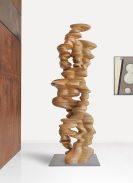
Etienne Beothy
1897 Heves, Ungarn
1961 Paris
Etienne Beothy, born on September 2, 1897 as István Beöthy in the Hungarian town of Heves, was an architect and sculptor whose complete works are unconventional and independent. Although Beothy was not one of the great innovators of modern sculpture, his works – in which theoretical fundamentals and artistic free designs are closely intertwined – stimulated new developments through their consequence and determination.
After the First World War, Beothy registered at the Architecture College in Budapest. Already in 1919, he summarized his reflections on the theory of proportions and, above all, on the golden ratio in the treatise La Serie d’Or. This was to become the theoretical foundation of his work, but the text was only published twenty years later. In 1919, Beothy became friends with László Moholy-Nagy and the avantgardist artist group MA (today) around Lajos Kassák, which was primarily influenced by constructivism and suprematism. Consequently, Beothy’s first works exhibited an architectural-constructivist influence. In all of his creative work, Beothy remained "architectural" and combined mathematically calculated construction with free artistic design.
In 1920, Beothy switched to the Budapest College for Fine Arts and concentrated on sculpture. With a graduation scholarship, he travelled through Austria, Germany, England, and Italy beginning in 1924 and finally settled in Paris in 1925. The phase of experimentation was also over at this time. Beothy wanted to translate what he theoretically formulated in the golden ration into three-dimensional terms. He began with the human figure, but distanced himself increasingly from it through the course of the years. The artist discovered wood, which then became his preferred material.
In 1928, Beothy became well-known in Paris with a successful series of exhibitions. This was followed by individual and group exhibitions throughout all of Europe. Together with his friend Auguste Herbin and Georges Vantongerloo, he co-founded the important artist association Abstraction-Création in 1932 and was its vice-president until 1936. In 1938, Beothy organized the first exhibition of French and Hungarian abstract art in Budapest. In 1939, he published his Serie d’Or, in which he attempts to prove that every work of art has a mathematical starting point. The publication occurred at an extremely inopportune point in time because the constructive art trends, which had dominated until the mid-1930s, lost their influence; in addition, there was little interest in art at that time because of the beginning of the Second World War. Beothy’s treatise received very little attention.
Beothy became involved in the Résistance during the Second World War. From 1941 to 1943, he headed the resistance group of Hungarian intellectuals and artists in Paris. He represented this group in 1946 at the Exhibition of International Modern Art at the invitation of UNESCO. This was followed by additional important exhibitions throughout all of Europe.
Beothy also continued his theoretical works. He devoted his attention to the examination of color. Unfortunately, Etienne Beothy could not realize his plans for the development of an exact theory of color and proportion.
On November 28, 1961, Etienne Beothy died unexpectedly of heart failure in Paris.

Would you like to sell a work by Etienne Beothy?
Infos for seller






